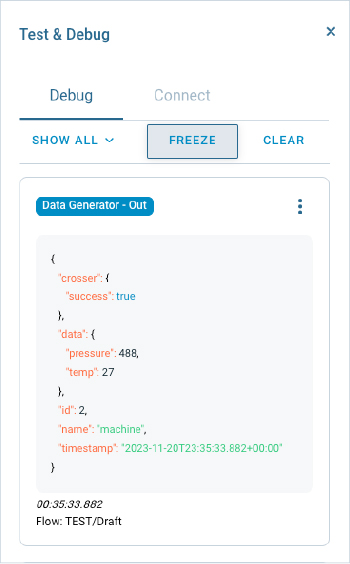Testing Flows and pipeliens with real data
 Once you have completed a new or modified Flow it’s time to test it. You do this by connecting the Flow Studio tool to a Node. There are two options here:
Once you have completed a new or modified Flow it’s time to test it. You do this by connecting the Flow Studio tool to a Node. There are two options here:-
Sandbox - If your Flow only access systems that can be reached from the Internet or has no external connectivity you can use a Node hosted by Crosser to test your Flow. We call these Sandboxes.
- Local Node - If your Flow connects into on-premise system, e.g. PLCs or databases, you have to test the Flow on a Node that has access to these systems.
To connect the editor to a Node for testing you click on the Test & Debug button in the right-side menu bar.
This will open up the test & debug panel which has to tabs: Connect and Debug. On the connect tab you will see a list of Nodes that are available in your org. Some Nodes may be grayed out because they are not compatible with the version requirements for the current Flow.
Click on the Node you want to use or expand the sandbox section and click connect. When you are connected the Node will get a green checkmark and the name is shown in the top-right corner above the canvas.
You can now start the Flow using the start button () next to the name of the Node. The Flow will now be downloaded by the Node and then start executing. The panel then switches to the debug tab and the area with the Node name will get a green background to show that the Flow is running. Messages from any modules that have debug enabled (see above) will now show up in the debug panel.
You can freeze the debug window which will stop new messages to be added, if you want to look more carefully at the present messages. If you have complex messages you can also open them in a separate pop-up window using the menu in the upper-right corner of each message. Here you can also copy the message as JSON text. you stop the Flow using the Stop button () next to the start button.
Switching tabs during remote sessions
A remote session is always tied to a specific Flow and you can only have one remote session at a time. Once you start a Flow the session will be tied to that Flow. If you switch to another Flow tab your session will remain active with the previous Flow, but you will not see any debug messages and the Start/Stop buttons are disabled. When you go back to the tab with the flow connected with the remote session they will be active again. If you want to switch your remote session to another flow, go to that tab and then connect the Node again.

